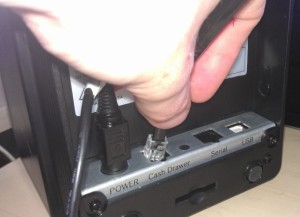Thanks, Insane Clown Posse. Now that I’ve stolen the title, I’ll leave the rest of this meme alone, but if you’re not easily offended by foul language or questionable talent, feel free to ask the same question of YouTube about magnets for some deep insight into the world. I think it’s hilarious because I don’t think the lyrics are even slightly ironic, but my sense of humor is less than refined.
Just as magnets are a deep mystery to some humans on earth, so are cash drawers to (I hope) a much larger percentage of the population. How do cash drawers work? Who cares? Not even cashiers care, cash drawers just work. Total the sale, enter cash transaction, and it opens. Seriously, who cares?
Okay, one guy cares. The guy who has to make it work cares and if you’re starting a small business, you might be inclined to roll your own POS terminal. That makes you the guy (gender neutral, of course) that needs to care. Following is a very brief explanation of cash drawer interfaces.
Manual Cash Drawer
A glorified cigar box with a key. Hey, you gotta crawl before you can walk, right? Money is tight and you’re the only one using the cash drawer anyway. No shame in a manual drawer. Key locks the drawer. Mechanical push-button opens the drawer when unlocked for business, does not open when locked. Simplicity has never been so simple.
Printer Driven Cash Drawer
This is your fancy automatic drawer of the most popular type. It plugs into your receipt printer and waits for the printer to tell it to open. The printer waits for your Point of Sale (POS) application to tell it to print a receipt and that yes, this transaction is cash money, so please open the drawer. A few cash drawers come with interface cables that support Star Micronics and Epson printers, but don’t assume. You need a cable and you’re not going to be able to buy it at Best Buy on Saturday afternoon. The cables are sold by the drawer manufacturers and are usually specific to the printer that they’re attached to.
USB Cash Drawer
This sounds like it should be a slam dunk, but it isn’t. Sure, you have an extra USB port on your POS terminal, but you need your POS application to be able to speak cash drawer, and many of them don’t. Most of them speak receipt printer and ask the printer to speak cash drawer to the um, cash drawer. Do not buy a USB driven drawer unless it’s specifically supported by your POS application vendor. USB drawers also require additional electronics to communicate with POS applications, so there is a non-negligible increase in cost.
An interesting point about the screen shot above. Notice that you can set the printer to only open for cash or for cash and check. A “media slot” refers to a slot in the face of the drawer that allows the cashier to deposit a check or coupon into the drawer to be deposited under the till without opening the drawer. The first image in this post features a manual drawer with two media slots.
Serial (RS232) Cash Drawer
RS232 is a communication protocol driven by (usually) a 9 pin serial connection to the PC. Your typical off-the-shelf PC doesn’t even have a serial port anymore. Dedicated POS terminals usually still do, but it’s about as legacy as legacy computing gets. If your POS vendor requires a serial cash drawer, you might want to ask them why? It’s kind of like a Chevy Celebrity. There was a time and a place, but it’s never been better than the alternatives that came after.
Feel free to contact L-Tron and talk to me or one of the other POS aficionados before making your purchase. If you do something weird with your order, we’re going to call you before we ship it anyway! If you know what you’re doing and we call to ask you about it, just tell us “I know what I’m doing.” and we won’t bother you again. We just want your stuff to work when you get it. The end.



